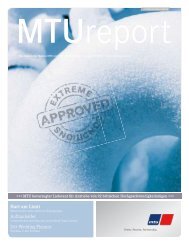Create successful ePaper yourself
Turn your PDF publications into a flip-book with our unique Google optimized e-Paper software.
Marine<br />
They lie hidden, often hundreds of meters<br />
below the surface of the water – but their<br />
effect is devastating. Today there are still<br />
well over 200,000 sea mines at the bottom<br />
of the Baltic Sea. They are left over from<br />
the Second World War and seriously limit<br />
commercial fishing and merchant shipping<br />
operations. If they are not spotted and a ship<br />
happens to pass over them, there will be no<br />
help for the vessel and its crew. That is why<br />
the Finnish Navy is aiming to commission<br />
three new minehunters in 2015 – costing<br />
a total of €250 million. <strong>MTU</strong> is supplying<br />
specially demagnetized engines both for<br />
propulsion and onboard power generation<br />
on the new ships.<br />
Some things are just there all around us,<br />
unnoticed and taken for granted. Like the air we<br />
breathe, for example. Or the sun, without whose<br />
light and warmth we could not survive. The<br />
Earth’s magnetic field is another example. None<br />
of us is aware of it, but without the magnetic<br />
attraction of the poles, our world would be<br />
entirely different. Highly energized particles from<br />
the sun or outer space would very likely make<br />
life on Earth impossible if they were not trapped<br />
by the magnetic field thousands of kilometers<br />
above the planet. Whales, sharks and turtles<br />
use the magnetic field as a navigation aid. But<br />
it is also used by sea mines for more sinister<br />
purposes. They are fitted with magnetic sensors<br />
so that they can detect when ships that they are<br />
programmed to destroy are close by. The job of<br />
seeking out mines and rendering them harmless<br />
is the purpose of a minehunter. The Finnish Navy<br />
is currently in the process of commissioning<br />
three such new vessels. The 52-meter craft<br />
will each be powered by two 8-cylinder <strong>MTU</strong><br />
Series 396 engines. In this type of application,<br />
the performance of the engines is a secondary<br />
consideration because, when on minesweeping<br />
duty, the ships travel at no faster than five<br />
knots (9.3 kph). So that the minehunters can<br />
slip as silently as possible through the water,<br />
the engines have double resilient mountings.<br />
And their magnetic signature has all but been<br />
indistinguishably erased.<br />
Accuracy and precision<br />
Building such engines is a highly complex<br />
process that takes several weeks. “We need<br />
well over a hundred hours for one engine,” said<br />
Albert Hagenlocher, test track manager at <strong>MTU</strong>.<br />
That is because the engine is not demagnetized<br />
all at once. Hagenlocher has to demagnetize<br />
every component individually. The crankshaft,<br />
the camshaft, the con rods, the turbocharger,<br />
the cylinder heads and even the bolts – 16,000<br />
components for every engine. A lot of work by<br />
any standards. “But that is how we make sure<br />
that the magnetic signature of the components<br />
remains permanently weak,” he said, seemingly<br />
lost in his own thoughts as he placed a cylinder<br />
liner inside a demagnetizing coil.<br />
Permanent and induced magnetic signatures<br />
At this point the magnetic signature is still very<br />
strong. A sea mine would immediately detect an<br />
engine with this component in it, and explode.<br />
To weaken the magnetic signature, the test<br />
track manager passes an electrical current with<br />
a special wave envelope through the coil. The<br />
wave envelope has a total of eight variables. The<br />
frequency and maximum strength of the current<br />
flowing through the coil are two of them. Setting<br />
exactly the right wave envelope is a very precise<br />
art. “You can’t teach this,” claimed Hagenlocher<br />
with a mischievous grin. He maintains it is much<br />
more a matter of experience, because every<br />
magnetic component has two different magnetic<br />
signatures – a permanent and an induced one.<br />
The permanent signature of the cylinder liner<br />
is something he can erase; but not the induced<br />
signature. That is determined by the Earth’s<br />
magnetic field, and it fluctuates constantly as<br />
well as varying between geographical regions.<br />
The Finnish minehunters are initially to be<br />
used only in the Gulf of Finland. But even that<br />
geographical limitation is far too wide-ranging.<br />
After Albert Hagenlocher has erased the magnetic signatures from all of the individual components, the engine can be assembled.<br />
The Ranging Facility Manager can then check the strength of the engine’s residual signature on a test track.<br />
<strong>MTU</strong> Report 03/12 I 55


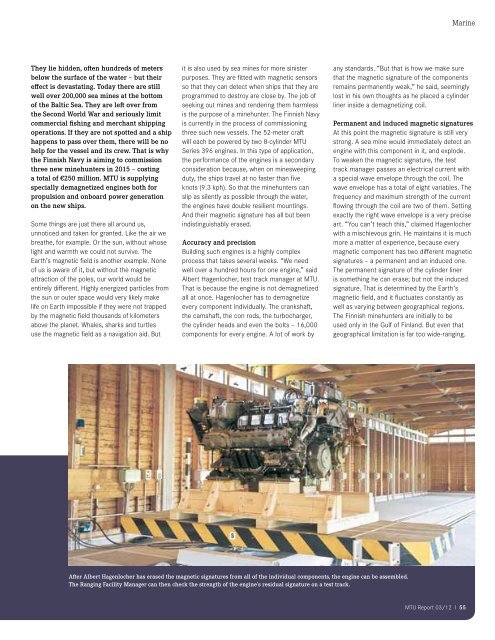
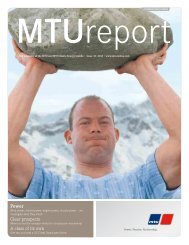

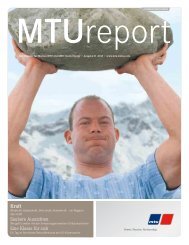
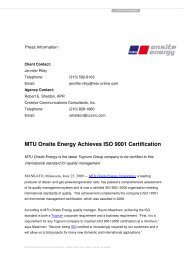

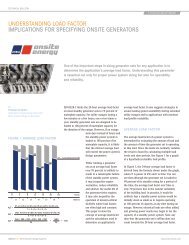


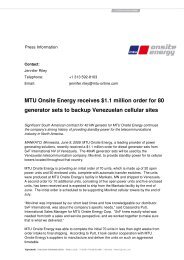

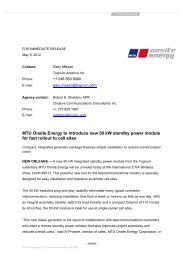

![Full power range of diesel generator sets [PDF] - MTU Onsite Energy](https://img.yumpu.com/28297693/1/190x253/full-power-range-of-diesel-generator-sets-pdf-mtu-onsite-energy.jpg?quality=85)
